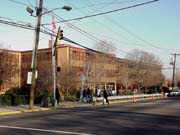Three years ago, North Bergen Mayor Nicholas Sacco, who also serves as the assistant superintendent of schools for the township’s school district, had an idea that stemmed from personal experience.
“My son [Nick] went to North Bergen High School and before he took the SAT [Scholastic Aptitude Test], I sent him to the Princeton Review to get ready,” Sacco said. “I knew then that we had to do something more in the school, to fit within the structure of the school day.”
North Bergen High School Vice Principal George Solter and Math Supervisor Dr. Edward Sahagian were then put to work to devise a way for the school’s juniors to become better prepared to take the standardized tests and improve their test scores.
“In comparison to Hudson County and to other parts of the state, we weren’t doing as well as we thought we should in the SATs,” Solter said. “We wanted to give our students the best chance of getting into the college of their choice and SAT scores shoot you into college. We came up with a couple of different things and the best solution was the Princeton Review course.”
The Review guides millions of students each year through the transition from high school to college, to professional studies. Through its courses, books, software, and online services, The Review offers tips and tools for students, parents, teachers, guidance counselors, and admissions directors.
Having begun in a New York City apartment with fifteen SAT students in 1981, The Review is now the world’s best test-preparation company, offering courses in over seventy cities in the U.S. and abroad.
However, the major obstacle for most of the town’s students was the cost of taking the Review course, which is estimated at $1,200.
“Our kids don’t have the money to pay for the Princeton Review course,” Solter said. “It just didn’t work.”
Sacco, Solter, and Sahagian brainstormed and tried to figure a way that they could best serve the students of the district, using the Review as a guide. They first introduced a program for after school and Saturday mornings, but found that the program wasn’t successful.
“It was overcrowded and didn’t work,” Sacco said.
“A lot of our kids work after school or have to take care of younger brothers or sisters,” Sahagian said. “It had to be instituted during the school day.”
The staff of the Review agreed to help. The organization said that it would train the school’s teachers in their system at no cost so that the teachers could then prepare the students during class time. The teachers are paid a stipend for teaching the SAT classes during their free periods as well.
The students then surrendered two study periods a week to participate in the program, one period for math and one for English.
“Most of the kids spend their study period either reading or actually doing nothing,” Solter said. “This way, we put the period to practical use. It had to be accessible to the students, because without it, there would really be no benefit.”
“The class structure is much more effective,” Sacco said.
The juniors then attend the special classes for 10 weeks before taking the SAT for the first time. The classes are geared toward test-taking strategies and techniques.
When the classes were offered to the students, the response was overwhelming. Almost 400 of the high school’s 425 juniors registered to take the training sessions, giving of their allotted free time to better their college preparatory test scores.
“We had a tremendous turnout,” Sahagian said. “The students are definitely aware of what’s going on and they’re taking advantage. I have to give them credit for taking the time and making the effort.”
The results have been amazing. In the first two years of the program, the town’s collective SAT scores have improved on an average of 100 points – which is what the Review course guarantees.
High school senior Eric Macias is a glowing example of how the program has worked. When Macias first took the SAT, he received a score of 1,030, which is a better than average result. However, after participating in the course, Macias scored a 1,290.
Combined with his 3.7 grade point average and the new score, Macias was able to secure a grant-in-aid package to play football at Columbia University.
“It really helped me a great deal,” Macias said. “I owe it all to them. I wanted to go to the SAT classes to try to apply myself more. I had some one-on-one tutoring, but the classes were a big help.”
Sahagian said that the SAT prep classes are also helping the students prepare for another crucial test, the state-mandated High School Proficiency Assessment (HSPA), which the same students will take in May.
“They need to past the HSPA in order to graduate,” Sahagian said. “We have been able to expand their skills and gear them toward the HSPA as well. We’ve learned that the math in the HSPA is almost identical to what the Princeton Review provides, so we’ve expanded the program this year to include the HSPA.”
“I think we’ve created a win-win-win situation,” Solter said. “The kids are getting better SAT scores and that was the main goal. The teachers are receiving a stipend and we now have a more manageable study hall, with kids in organized classrooms. It’s really working well.”
Sahagian said that the advantages go even further.
“The teachers are now using the strategies in their regular classrooms,” Sahagian said. “Their teaching approach is different. You can really see the difference in the classrooms.”
